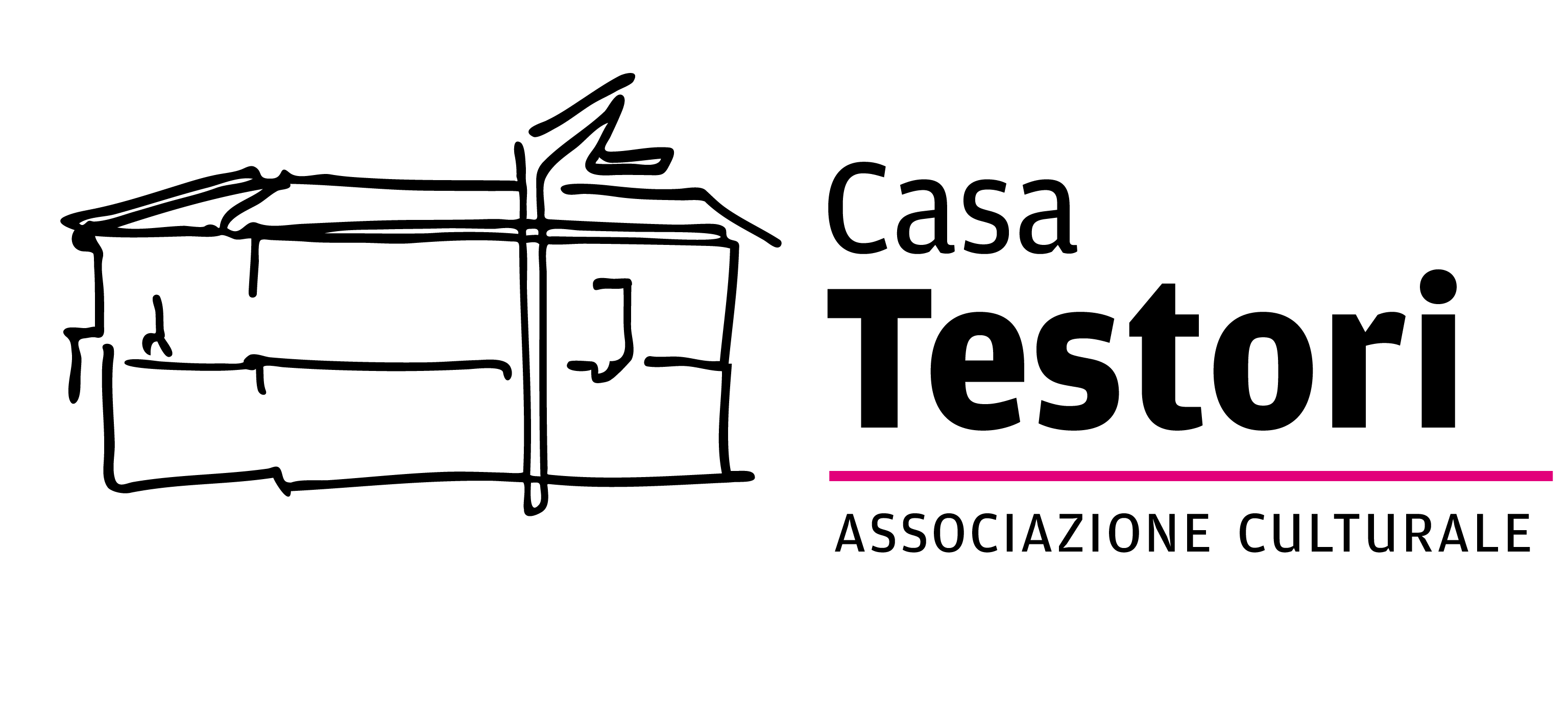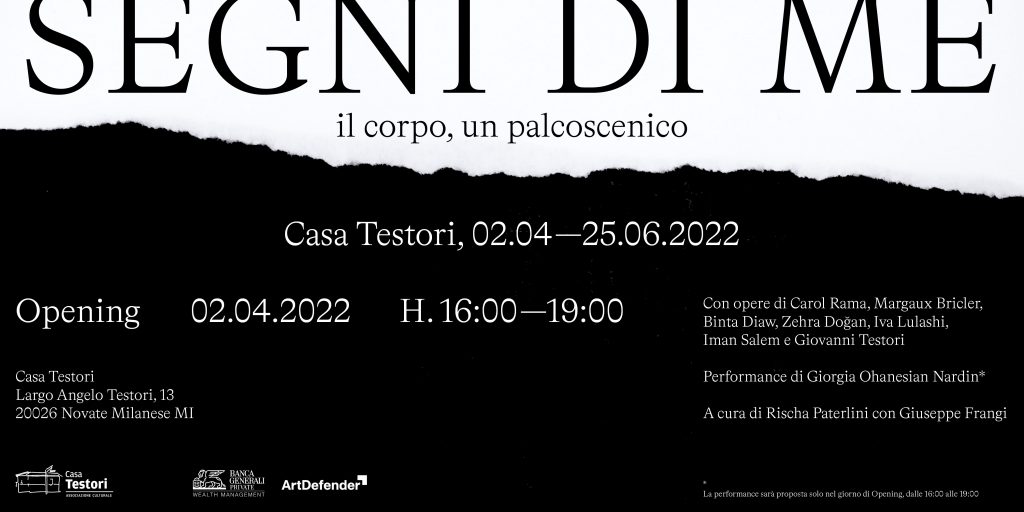SEGNI DI ME. IL CORPO, UN PALCOSCENICO
Margaux Bricler, Binta Diaw, Zehra Doğan, Iva Lulashi,
Giorgia Ohanesian Nardin, Iman Salem
In dialogue with: Carol Rama and Giovanni Testori
Curated by Rischa Paterlini with Giuseppe Frangi
Casa Testori
2 April – 25 June 2022
Graphic project: CH RO MO/Roberto Montani.
After the experience of the exhibition Libere Tutte in 2019, Casa Testori continues the path dedicated to what Lea Vergine had renamed “the other half of art” and adds a piece to the story written by many feminist artists at the end of the 1960s by addressing with more radicality themes related to the body and the entity.
SEGNI DI ME. Il corpo, un palcoscenico presents six young artists born between 1985 and 1995, called to interact with a great figure of the recent past, Carol Rama. At the centre of their work is the relationship with the body, which becomes the terrain of artistic expression. Powerful and sometimes provocative works enter the rooms of Casa Testori, insisting on subjective experiences, criticising the painful legacy of sexism, violence and other power structures of contemporary culture.
These works provide new and valuable insights into both historical and contemporary art. The exhibition is conceived as if it were a play, with the help of a wide range of media including paintings, sculptures, performances, drawings and photographs. An eighth protagonist then enters the scene, the host Giovanni Testori, with a series of large drawings from the mid-1970s that have the female body as their subject.
Curated by Rischa Paterlini with Giuseppe Frangi, the exhibition brings to the rooms of the Novate Milanese residence, in addition to Carol Rama and Giovanni Testori, the works of Margaux Bricler, Binta Diaw, Zehra Doğan, Iva Lulashi, Giorgia Ohanesian Nardin and Iman Salem.
Interweaving the eroticism of Iva Lulashi’s painting, the sensuality of Binta Diaw’s photographs, Zehra Doğan’s deformed figures, Margaux Bricler’s sculptures or sphinxes, animal, female and demonic figures, Giorgi Ohanesian Nardin’s long live performance and Iman Salem’s photographs, with the historical works of Carol Rama and Giovanni Testori, the exhibition stages stories in which carnality and passion mix. By being represented, the body becomes objectified: this mechanism is the direct criticism not only of the visual clichés we are used to, but also of the ways of viewing it.
The young artists invited, highlighting their commitment to reclaiming the body and going beyond the historical legacy of feminism, have developed works of great intensity, generating an encounter-counterpoint that finds further reflection where each element is a fragment of a body on an empty stage. These fragments of works-bodies make it possible to achieve balances of considerable formal and aesthetic intensity that are highly involving for visitors.The exhibition was inspired by the words on the invitation that African-American artist Kara Walker wrote for her first solo show in New York at the Wooster Gardens/Brent Sikkema gallery in 1995, “The High and Soft Laughter of the N*****s Wenches at Night”, which read as follows: «Don’t miss the incredible “paper story” of a black woman in slavery who tells of her extraordinary escape to freedom». These words are put in relation to those of an article that Giovanni Testori wrote in 1979 for the front page of the Corriere della Sera, La vergogna dello stupro (The shame of rape): «We would not want that, as is happening with other shames and crimes, by dint of talking, writing and discussing about them, without ever taking responsibility for a gesture, we would end up accustoming man to what is not human. The habit of everything is one of the greatest risks that man is running; the negative impulse that wants to reduce him to a “thing” is leading him to it. Now the end point of this risk cannot be a new consciousness, but the darkness and the night that opens up over the eliminated or destroyed consciousness».
THE PROJECT
The rooms on the ground floor of Casa Testori are dedicated to site-specific works by Margaux Bricler, Binta Diaw, Zehra Doğan and Iva Lulashi. For the opening Giorgia Ohanesian Nardin and Iman Salem will present a performance that will be documented in the exhibition with photographs taken by Iman Salem. On the walls of the large hall, there is a tribute to the artist Carol Rama, whose work has proved to be a valuable reference for many contemporary women artists, in particular for her modern vision of femininity and her way of representing her own body since the 1930s, intolerant of bourgeois constraints and hypocrisies. Intense works from the 1960s celebrating an identity that was both refined and animalistic, and which anticipated a new way of feeling: materials such as rubber, glass eyes, skins, hair and nails are elements that recur in these works, true enactments of her own identity.
My works – said the artist in 1997 answering a question form Corrado Levi – will be very much liked by those who have suffered, and who have not known how to get out of suffering… Because having had a mother in a psychiatric clinic and having also felt well in that environment there… Because I started in that way there to be with gestures and ways without preparation neither cultural nor of etiquette… I believe that everyone will love those gestures more, because they are gestures that, for reasons that I don’t dare to say, belong to everyone… Because madness is close to everyone… And there are absolutely those who deny it… And those who deny it are just mad, melancholic, sad, unapproachable… Because it is like culture. Culture is a privilege, which I could have done too… But I have always felt more flexible to drawing, to a painting, a story, a composition.
A room on the ground floor allows the works to be viewed only from the outside, through a hole. Inside are some works that Giovanni Testori created in 1975 and exhibited at the Galleria del Naviglio in Milan: large graphite papers with close-ups on female anatomical subjects.
The exhibition has been realised thanks to the collaboration of Galleria del Ponte, Turin and Prometeogallery, Milan and thanks to the support of Banca Generali and Art Defender.
Catalogue with texts by: Corrado Levi, Giovanni Testori, Giuseppe Frangi, Rischa Paterlini, Marlene L. Müller.
Posted on: 28 March 2022, by : Alessandro Ulleri














